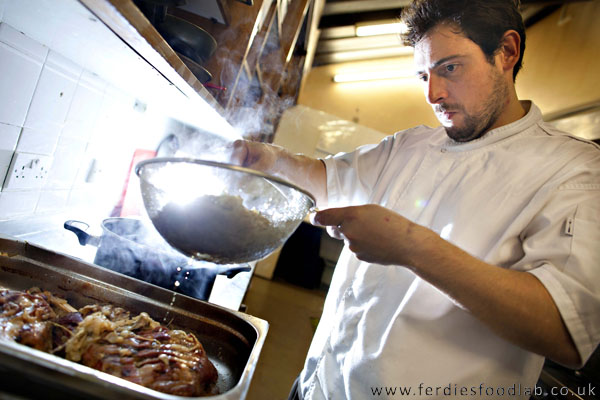This recipe is inspired by my travels in Cambodia. I can't claim to be able to get hold of any prahoc, but I can claim to have been exposed to a serene culture, with an amazing and, frankly, dark past. I have mixed memories of land mine museums, electric bicycles, and the most friendly population I've ever encountered on my travels. Recovering from a pretty grim past I found the Cambodian people really welcoming. What to see? Jungle, elephants, amazing stonework sculpture and temples.
 |
| We'll take you to the floating village - come with us!! - Little monkeys! |
 |
| Angkor Wat popping out of the jungle - although I didn't know it at the time, this was to be one of the happiest holidays of my life! |
 |
| That's an elephant's arse!! How did that get in there? |
I have to be honest - the food in Cambodia was a pretty hit and miss thing! This one sticks in my memory, I tried to get the recipe from the chef, a little old Cambodian woman, but it was a hopeless task since we had no common language (except food) whatsoever. I had to do a little research to get it right, but it's pretty faithful! It's mostly about the sauce, great depth!
 |
| Just look at that, what a stunning view! |
Prahoc is a fermented fish paste, made from mudfish & gourami, amongst other things. It is widely used in Khmer cuisine. Try finding that in the supermarket!! Tuk prahoc is a liquid made by adding prahoc to boiling water and leaving over night
I've used shrimp paste instead of prahoc, and in the photos some leftover ribeye roast beef. I used sirloin steak last time I made it for supper club. This is a gorgeous recipe, great summer food!
 |
| You can use whichever steak you prefer, for this salad, my preference is sirloin or ribeye. |
ingredients (serves 4)
for the salad and chips
750g sirloin - seared and thinly sliced - raw in the middle
400g sugar snap peas (julienne - diagonal)
800g Maris Piper potatoes
for the salad and chips
750g sirloin - seared and thinly sliced - raw in the middle
400g sugar snap peas (julienne - diagonal)
800g Maris Piper potatoes
 |
| From bottom CW: garlic, shrimp paste, lime, palm sugar & lemon grass. Got everything but the shallot!!! |
for the sauce
2 lemon grass (blended)
2 shallots (blended)
2 cloves garlic (blended)
50g palm sugar (blended)
3 limes (juiced)
3.5g shrimp paste (+50ml boiling water)

2 shallots (blended)
2 cloves garlic (blended)
50g palm sugar (blended)
3 limes (juiced)
3.5g shrimp paste (+50ml boiling water)
for the garnish
2 birdseye chilli (fine sliced rings)
15g coriander (chopped coarse, stalks ok)
70g peanuts (coarsely ground)
sprinkling of garlic chives (optional)
apparatus
heavy based pan
fine sieve
beef salad and chips
Cut up the sugar snaps in long diagonal strips, take off any tough stalky bits, of which there should be very few, and place them in a salad bowl ready to mix. Use your favourite method to make chips, I'd suggest a 10mm square cross section, the rest I'm leaving for another post! Put them somewhere where they will keep warm in a tray lined with kitchen towel.
2 birdseye chilli (fine sliced rings)
15g coriander (chopped coarse, stalks ok)
70g peanuts (coarsely ground)
sprinkling of garlic chives (optional)
apparatus
heavy based pan
fine sieve
beef salad and chips
Cut up the sugar snaps in long diagonal strips, take off any tough stalky bits, of which there should be very few, and place them in a salad bowl ready to mix. Use your favourite method to make chips, I'd suggest a 10mm square cross section, the rest I'm leaving for another post! Put them somewhere where they will keep warm in a tray lined with kitchen towel.
 |
| Chips glorious chips . . . hot chocolate and biscuits? |
For the photography, I used some leftover roast ribeye of beef and pan seared it. Very, very nice! (Video of how to roast ribeye coming soon) If using sirloin, remove the fat and cut it into 1.5cm (1/2 inch) steaks, and marinate them in a little of the sauce for a couple of hours. Bring the meat to room temp before cooking: this way it's not cold in the middle after searing. Cooking the steak should be the last thing you do! When you're ready, bring a heavy-based pan up to a high heat, pop a glug of olive oil in with the steaks, make sure they're coated with it, season lightly and put in the pan. Turn them a couple of times, once they're golden brown it's time to whip 'em out. Slice thinly across the grain, and serve immediately! The thinner you slice the faster the meat will go cold, so not too thin! Think of that gorgeous, steamy, beefy goodness!!
 sauce (overnight infusion - or first thing in the am)
sauce (overnight infusion - or first thing in the am)Bring the water to the boil in a pan and add the shrimp paste. Stir until dissolved, then leave to cool.
Once cool, add the sugar and dissolve. Blend the rest of the ingredients and add them, then leave the mix in the fridge overnight. In the morning sieve the mix. It's now ready to use.
garnish
 |
| Now that's and explosion of flavours, sharp and light! |
Personally, I don't mind a few chilli seeds in my salad. If you're not of that persuasion, cut the stalk end of the chilli off at it's widest point, roll it between your index finger and thumb to release the seeds, then slice it into rings.
Coarsely chop the peanuts with a knife or with a couple of pulses of your blender. Do not powder them! They contribute a great texture and flavour, if there are quarter peanut-sized lumps in there that's great!!
The coriander is fine torn by hand, stalks and all!!
Coarsely chop the peanuts with a knife or with a couple of pulses of your blender. Do not powder them! They contribute a great texture and flavour, if there are quarter peanut-sized lumps in there that's great!!
The coriander is fine torn by hand, stalks and all!!
thinking ahead
Make the sauce the night before, so those flavours really infuse with each other.
Make the sauce the night before, so those flavours really infuse with each other.
to serve
Place the steak on a bed of peas, dress with coriander, chilli and peanuts and sauce serve with bowl of chips (making sure your plates are hot!)
Place the steak on a bed of peas, dress with coriander, chilli and peanuts and sauce serve with bowl of chips (making sure your plates are hot!)
Thank you Cambodia!





















